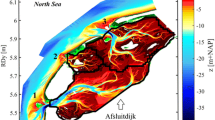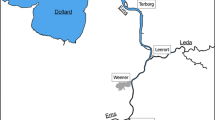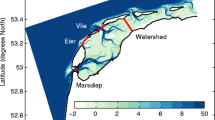Abstract
Water level records at two stations in the Guadalquivir Estuary (Spain), one near the estuary mouth (Bonanza) and one about 77 km upstream (Sevilla), have been analysed to study the amplification of the tide in the estuary. The tidal amplification factor shows interesting temporal variation, including a spring-neap variation, some extreme low values, and especially the anomalous behaviour that the amplification factor is larger during a number of periods. These variations are explained by data analysis combined with numerical and analytical modelling. The spring-neap variation is due to the quadratic relation between the bottom friction and the tidal flow velocity. The river flood events are the direct causes of the extreme low values of the amplification factor, and they trigger the non-linear interaction between the tidal flow and suspended sediment transport. The fluvial sediment input during a river flood causes high sediment concentration in the estuary, up to more than 10 g/l. This causes a reduction of the effective hydraulic drag, resulting in stronger tidal amplification in the estuary for a period after a river flood. After such an event the tidal amplification in the estuary does not always fall back to the same level as before the event, indicating that river flood events have significant influence on the long-term development of this estuary.















Similar content being viewed by others
References
Amin M (1983) On perturbations of harmonic constants in the Thames Estuary. Geophys J R Astron Soc 73:587–603
Beardsley RC, Candela J, Limeburner R, Geyer WR, Lentz SJ, Castro BM, Cacchione D, Carneiro N (1995) The M2 tide on the Amazon shelf. J Geophys Res 100(C2):2283–2319
Chernetsky AS, Schuttelaars HM, Talke SA (2010) The effect of tidal asymmetry and temporal settling lag on sediment trapping in tidal estuaries. Ocean Dyn 60:1219–1241. doi:10.1007/s10236-010-0329-8
DiLorenzo J, Huang L, Thatcher L, Najarian ML, T. O (1993). Dredging impacts of Delaware estuary tides. Proc. 3rd Int. Conf. Sponsored by the Waterway, Port, Coastal and Ocean Division, ASCE Estuarine and Coastal Modeling III, Oak Brook, IL, 86–104
Dronkers JJ (1964) Tidal computations in river and coastal waters. Elsevier, New York
Elias EPL, Gelfenbaum G, Van der Westhuysen AJ (2012) Validation of a coupled wave-flow model in a high-energy setting: the mouth of the Columbia River. J Geophys Res Vol 117, C09011. doi:10.1029/2012JC008105
Flick RE, Murray JF, Ewing LC (2003) Trends in United States tidal datum statistics and tide range. J Waterw Port Coastal Ocean Eng 129:155–164
Gabioux M, Vinzon SB, Paiva AM (2005) Tidal propagation over fluid mud layers on the Amazon shelf. Cont Shelf Res 25(2005):113–125
Godin G 1991, Frictional effects in river tides, in Progress in Tidal Hydrodynamics, edited by B.B. Parker, John Wiley New York
Godin G (1999) The propagation of tides up rivers with special considerations on the upper Saint Lawrence River. Estuar Coast Shelf Sci 48:307–324
Jay DA (1991) Green’s law revisited: tidal long-wave propagation in channels with strong topography, J. Geophys. Res., VOL. 96, NO. Cll, PAGES 20,585-20,598
Jay DA (2009) Evolution of tidal amplitudes in the eastern Pacific Ocean. Geophys Res Lett 36:L04603
Jay DA, Flinchem EP (1997) Interaction of fluctuating river flow with a barotropic tide: a demonstration of wavelet tidal analysis methods. J Geophys Res 102(C3):5705–5720
Jay DA, Leffler K, Degens S (2011) Long-term evolution of Columbia River tides. J Waterw Port Coast Ocean Eng 137:182–191
Jay DA, Flinchem EP (1999) A comparison of methods for analysis of tidal records containing multi-scale non-tidal background energy. Cont Shelf Res 19:1695–1732
Jensen J, Mudersbach CH, Blasi CH (2003) Hydrological changes in tidal estuaries due to natural and anthropogenic effects. Proc., 6. Int. MEDCOAST 2003-Conf., Ravenna, Italy.
Kukulka T, Jay DA (2003a) Impacts of Columbia River discharge on salmonid habitat: I. A non-stationary fluvial tide model. J. Geophys. Res., 108, 3293.
Kukulka T, Jay DA (2003b) Impacts of Columbia River discharge on salmonid habitat: II. Changes in shallow-water habitat. J. Geophys. Res., 108, 3294.
Moftakhari HR, Jay DA, Talke SA, Kukulka T, Bromirski PD (2013) A novel approach to flow estimation in tidal rivers, Water Resour. Res., 49, doi:10.1002/wrcr.20363
Munk WH, Anderson ER (1948) Notes on a theory of the thermocline. J Mar Res 7:276–295
Munk WH, Cartwright DE (1966) Tidal spectroscopy and predication. Philos Trans R Soc Lond Ser A 259:533–581
Pawlowicz R, Beardsley B, Lentz S (2002) Classical tidal harmonic analysis including error estimates in MATLAB using T_TIDE. Comput Geosci 28(2002):929–937
Soulsby RL, Wainwright BLSA (1987) A criterion for the effect of suspended sediment on near-bottom velocity profiles. J Hydraul Res 25(3):341–356
Talke SA, De Swart HE, de Jonge VN (2009) An idealized model and systematic process study of oxygen depletion in highly turbid estuaries. Estuar Coasts 32:602–620
Taylor PA, Dyer KR (1977) Theoretical models of flow near the bed and their implications for sediment transport. The Sea, 6, pp 579-601
Vanoni VA (1946) Transportation of suspended sediment by water. ASCE Transactions 111(2267):67–133
Villaret C, Trowbridge JH (1991) Effects of stratification by suspended sediments on turbulent shear flows. J Geophys Res 96(C6):10659–10680
Wang ZB (2000) Sediment transport modelling Guadalquivir River, WL | Delft Hydraulics. Report Z2073
Winterwerp JC, Lely M, He Q (2009) Sediment-induced buoyancy destruction and drag reduction in estuaries. Ocean Dyn 59(5):781–791
Winterwerp JC, Wang ZB (2013) Man-induced regime shifts in small estuaries—I: theory, submitted to Ocean Dynamics
Winterwerp JC, Wang ZB, Van Brackel A. Van Holland G, Kösters F (2013) Man-induced regime shifts in small estuaries—II: a comparison of rivers, submitted to Ocean Dynamics.
Woodworth PL, Shaw SM, Blackman DL (1991) Secular trends in mean tidal range around the British Isles and along the adjacent European coastline. Geophys J Int 104:593–609
Zijl F (2004) Salt Intrusion within the Guadalquivir River, Impact of additional fresh water extractions, WL Delft Hydraulics, Report Z3731
Acknowledgements
We want to thank Mario Fernández Bermejo from Navier Ingenieria, Spain for helping in collecting the filed data. We also would like to thank the two anonymous reviewers, whose comments helped us a lot to improve the manuscript. The study is partly supported by NWO via the project “Fate or future of intertidal flats in estuaries and tidal lagoons” within the framework of the Joint Scientific Thematic Research Programme (JSTP) between China and The Netherlands.
Author information
Authors and Affiliations
Corresponding author
Additional information
Responsible Editor: Bob Chant
This article is part of the Topical Collection on Physics of Estuaries and Coastal Seas 2012
Rights and permissions
About this article
Cite this article
Wang, Z.B., Winterwerp, J.C. & He, Q. Interaction between suspended sediment and tidal amplification in the Guadalquivir Estuary. Ocean Dynamics 64, 1487–1498 (2014). https://doi.org/10.1007/s10236-014-0758-x
Received:
Accepted:
Published:
Issue Date:
DOI: https://doi.org/10.1007/s10236-014-0758-x




